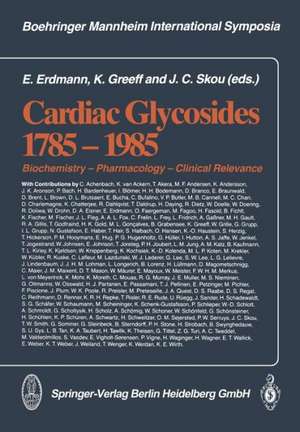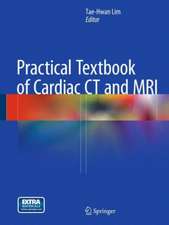Cardiac Glycosides 1785–1985: Biochemistry — Pharmacology — Clinical Relevance
Editat de E. Erdmann, K. Greeff, JC SKOUen Limba Engleză Paperback – 20 noi 2013
Preț: 1113.99 lei
Preț vechi: 1172.62 lei
-5% Nou
Puncte Express: 1671
Preț estimativ în valută:
213.19€ • 221.75$ • 175.100£
213.19€ • 221.75$ • 175.100£
Carte tipărită la comandă
Livrare economică 12-26 aprilie
Preluare comenzi: 021 569.72.76
Specificații
ISBN-13: 9783662112946
ISBN-10: 3662112949
Pagini: 576
Ilustrații: XVII, 552 p.
Dimensiuni: 170 x 244 x 35 mm
Greutate: 0.91 kg
Ediția:Softcover reprint of the original 1st ed. 1986
Editura: Steinkopff
Colecția Steinkopff
Locul publicării:Heidelberg, Germany
ISBN-10: 3662112949
Pagini: 576
Ilustrații: XVII, 552 p.
Dimensiuni: 170 x 244 x 35 mm
Greutate: 0.91 kg
Ediția:Softcover reprint of the original 1st ed. 1986
Editura: Steinkopff
Colecția Steinkopff
Locul publicării:Heidelberg, Germany
Public țintă
Professional/practitionerCuprins
William Withering — The man and his work.- Fruitful routes and blind alleys taken by digitalis therapy since its introduction by Withering.- Therapeutic use of digitalis until the time of William Withering.- The function of Na+, K+-ATPase and its importance for drug action.- Structural studies on the cardiac glycoside receptor.- Isoenzymes of Na/K-ATPase identified by pyrithiamin.- Interaction of cardiac glycosides with Na/K-ATPase in intact myocardium.- The human red blood cell: A model for ouabain receptor regulation in the heart?.- Binding and release of ouabain at low Mg2+ in reconstituted human red blood cell ghosts.- The ouabain receptor in the myocardium and conduction system of the sheep heart.- Electrophysiological effects of cardiac glycosides.- Electrophysiological assay of glycoside-induced sodium pump inhibition in isolated sheep heart Purkinje fibres at the onset of toxicity.- Rat cardiac hypertrophy: Contribution of heteregeneous digitalis receptor forms.- Digitalis receptors in normal and hypertrophied rat hearts. Differential effects of a Ca2+ free perfusion.- Biphasic contractile response to ouabain: Species specific? Calcium dependent? Altered sensitivity?.- The influence of ?-tocopherol-nicotinate (Renascin®) on cardiac glycoside effects.- On the connection between cardiac glycosides and calcium action.- Biochemical basis for the targeted synthesis of cardiac glycosides with selective action.- The “endogenous cardiac glycoside”.- Endogenous digitalis, cardiodigin and other regulators of the sodium pump.- Digitalis-like factors in plasma of healthy human adults.- A Na+,K+-ATPase inhibitor isolated from pig kidney.- Cardiac glycoside-like effects of a bufadienolide extracted from Kalanchoe Daigremontiana.- Positive inotropic agents: Differentmechanisms of action.- Significance of calcium ions in the regulation of myocardial contractility.- Additive and non-additive positive inotropic effects in human and guinea-pig myocardium.- The cardiac Na+/H+ exchange system. Its role in inotropy.- Evidence for pharmacodynamic differences between cardiac glycosides of different polarities.- The positive inotropic action of mercury compounds on isolated heart muscle.- Chronic pretreatment with amrinone or milrinone induces no tachyphylaxis in mammalian cardiac muscle.- Left ventricular function after oral milrinone in patients with congestive heart failure. A hemodynamic and angiographic study.- The importance of skeletal muscles as a distribution volume for digitalis glycosides in guinea-pigs and human subjects.- Relevant metabolism of cardiac glycosides.- The dihydrogenation of digoxin.- Renal excretion and plasma levels of dihydrodigitoxin in volunteers and renally healthy and renally insufficient patients being treated with digitoxin.- Enzymatic basis for digitoxin metabolism and possible drug interactions in man.- Effect of quinidine on the inotropic effect of digoxin in isolated cat or guinea-pig papillary muscle.- Quinidine decreases the intestinal secretion of digoxin and digitoxin in the guinea-pig.- Quinidine-induced reduction of the biliary excretion of digoxin in patients.- Role of the bile acid transport system in hepatocellular ouabain uptake.- Distribution of digoxin, digitoxin and their cardioactive metabolites in human heart and kidney.- Application of HPLC-DAD instead of the guinea-pig test for the quantitative determination of cardiac glycosides.- Interaction between 16-acetyl-gitoxin and drugs.- Digitoxin protein binding in patients on hemodialysis.- The effect of physical exercise on the distribution and renal excretion of digoxin.- Ouabain binding to erythrocytes from neonates, blood cord and pregnant women.- Extracardiac effects of cardiac glycosides.- Effects of digitalis on renal tubular sodium reabsorption.- Ouabain-induced efflux of catecholamines and metabolites from blood vessels of normotensive and hypertensive dogs.- Digoxin-specific antibody treatment of digitalis toxicity: Update.- Kinetics of the Fab fragments of digoxin antibodies and of bound digoxin in patients with severe digoxin intoxication.- Influence of tubular Na/K-ATPase activity on the development of hyperkalemia in digoxin intoxications.- 24-Hour-Hotter ECG in digoxin intoxicated patients.- Clinically relevant interactions with cardiac glycosides.- Importance of serum glycoside concentrations.- Metabolic aspects of compensatory mechanisms in cardiac failure.- Effects of digitalis glycosides on the systemic arterial and venous system: Clinical importance in the pathophysiology of congestive heart failure.- Attenuation of cardiac glycoside effects during long-term treatment.- When to start digitalis?.- Cardiotonic effect of digitalis in sinus rhythm during exercise.- Digitalis treatment in pulmonary heart disease.- Cardiac glycosides for paroxysmal atrial fibrillation?.- Cardiac glycosides in anaesthesia.- Effects of preoperative digitalisation on postoperative left heart performance and incidence of complications following hip surgery. First results of a prospective study.- Digoxin therapy and mortality following confirmed or suspected myocardial infarction: Experience in the MILIS study.- Improvement of ventricular function by treatment with ?-methyldigoxin in patients with sinus rhythm after extended myocardial infarction: An exercise-radionuclide-ventriculography study.- Effect ofintravenous digoxin on left ventricular contractility at rest and during isometric exercise in intact and pharmacologically denervated heart.- Low versus medium dosage digoxin therapy in patients with heart failure. A randomized, double-blind, cross-over study.- The effects of digoxin and xamoterol in patients with moderate cardiac failure.- The clinical, haemodynamic, and pharmacological consequences of withdrawal of digoxin after long-term treatment in patients with heart failure in sinus rhythm.- New positive inotropic agents: Advantages and disadvantages.- When should digitalis be discontinued?.



